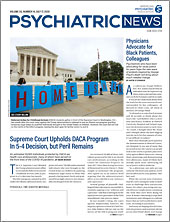In a surprising 6-3 decision, the Supreme Court ruled last month that individuals in the LGBTQ community are protected from discrimination in the workplace by Title VII of the Civil Rights Act of 1964.
“Today, we must decide whether an employer can fire someone simply for being homosexual or transgender,” wrote Justice Neil Gorsuch in the majority opinion. “The answer is clear. An employer who fires an individual for being homosexual or transgender fires that person for traits or actions it would not have questioned in members of a different sex. Sex plays a necessary and undisguisable role in the decision, exactly what Title VII forbids.”
The decision was related to a trio of cases that asked the court whether Title VII—which prohibits employee discrimination based on race, religion, national origin, and sex—applies to lesbian, gay, bisexual, transgender, and questioning/queer employees (
Psychiatric News).
The lawyers arguing on behalf of the employees who claimed they were fired due to discrimination used textualism, a style promoted by Justice Antonin Scalia, to make their point. They argued that, regardless of what Congress intended when it passed the Civil Rights Act, discrimination against LGBTQ employees is ultimately discrimination based on their sex and thus prohibited under Title VII.
“Those who adopted the Civil Rights Act might not have anticipated their work would lead to this particular result,” Gorsuch wrote in the decision. “But the limits of the drafters’ imagination supply no reason to ignore the law’s demands. … Only the written word is the law, and all persons are entitled to its benefit.”
APA joined an amicus brief in the case in which it expressed support for laws that “protect the civil rights of transgender and gender diverse individuals.”
“[T]he scientific literature regarding gender and sexuality supports the understanding that discrimination on the basis of sexual orientation and gender identity is discrimination because of sex,” the brief states. “Accordingly, laws like Title VII that prohibit sex discrimination reach—and must continue to reach—discrimination against sexual and gender minorities.”
Eric Yarbrough, M.D., chair of APA’s Council on Minority Mental Health and Health Disparities and past president of the Association of LGBTQ Psychiatrists, called the decision “a breath of fresh air for the LGBTQ community.”
“It was the first good news we’ve gotten in a while,” he said. Just three days before the Supreme Court decision, the Trump administration
overturned an Obama-era rule that extended discrimination protections in health care to LGBTQ individuals.
Yarbrough said he has worked with trans-identified patients who were fired from their jobs simply because they didn’t “fit in.”
“A lot of transgender individuals are going to be a lot less stressed going into work because they can dress and present themselves how they feel comfortable,” he said. “I think the world is going to have to become a little more open minded because the Supreme Court has now extended this protection to LGBTQ individuals.”
In his dissenting opinion, Justice Samuel Alito called the majority decision a “brazen abuse” of the Supreme Court’s authority. He argued that “the concept of discrimination because of ‘sex’ is different from discrimination because of ‘sexual orientation’ or ‘gender identity.’ ”
Alito also argued that the current understanding of the concept of gender dysphoria postdates Title VII’s enactment. He noted that it was not included in DSM-5 until the third edition, published in 1980. “It defies belief to suggest that the public meaning of discrimination because of sex in 1964 encompassed discrimination on the basis of a concept that was essentially unknown to the public at the time,” he wrote.
In making his argument, Alito referenced a paper published in the Journal of Gay and Lesbian Mental Health that Jack Drescher, M.D., wrote in 2010 titled “Transsexualism, Gender Identity Disorder, and the DSM.” Drescher is a psychoanalyst and clinical professor of psychiatry at Columbia University. He served on the DSM-5 Work Group on Sexual and Gender Identity Disorders.
Drescher’s article, which he wrote while working on DSM-5, describes the history of the diagnostic categories of gender identity disorder. “The purpose was to educate people about this population, how they’ve been affected by psychiatric diagnoses, and to find a way to make psychiatric diagnoses less stigmatizing,” he told Psychiatric News. “The intent of the paper was to reduce discrimination, and the intent of Justice Alito was to use it to allow discrimination.”
In the week after the Supreme Court issued its decision, Drescher said many of his patients began their sessions by expressing their happiness about the decision. “The silver lining is that two of the conservative justices were not persuaded by Alito’s argument,” he said. ■
The Supreme Court’s decision is posted
here.
“Transsexualism, Gender Identity Disorder, and the
DSM-5” is posted
here.

